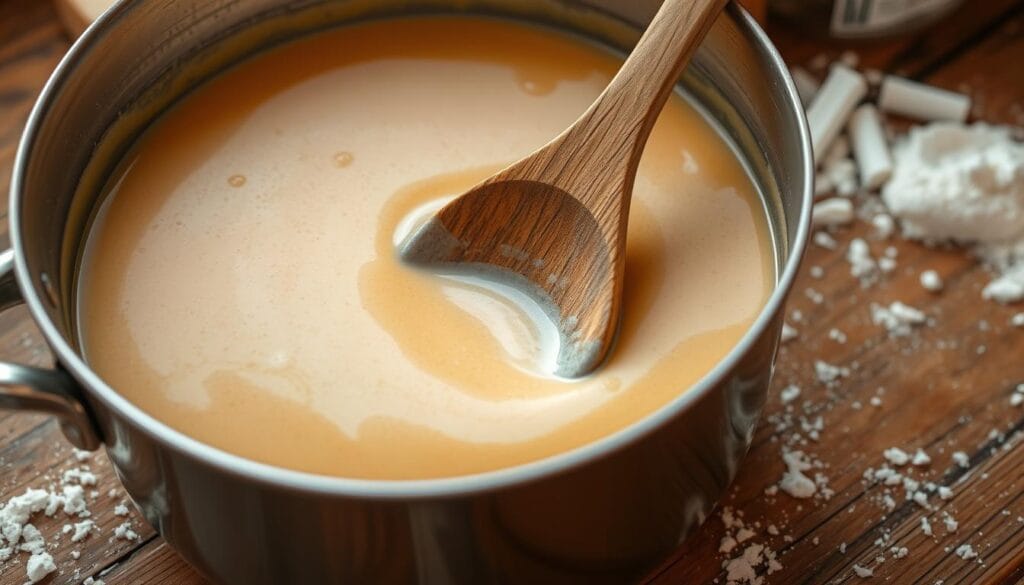I love mac and cheese and have spent hours making it perfect. I’ve tried many cheeses and techniques to get a creamy sauce. Here, I’ll share my secrets to make your mac and cheese creamy and delicious.
Mac and cheese is a favorite for any meal or party. But, getting it just right can be tricky. With the right ingredients and methods, you can enjoy creamy mac and cheese every time. Your family and friends will love it so much, they’ll ask for more!
Understanding the Basics of Mac and Cheese
Making the perfect mac and cheese is an art. It needs the right ingredients and cooking skills. Choosing the best cheese blend and preparing the pasta are key steps. Each one is important for a creamy, delicious dish.
Popular Cheese Choices for Creaminess
Choosing the right cheese is crucial for creamy mac and cheese. High-fat cheeses like sharp cheddar, Fontina, and Gruyère melt well. They make a smooth sauce. Don’t use aged cheeses with low moisture, as they melt poorly.
For the best taste, mix cheeses like sharp cheddar, mozzarella, and Gruyère. Freshly grated cheese is better than pre-shredded. Pre-shredded cheese may have additives that make it gritty.
The Importance of Pasta Type
The pasta type affects the mac and cheese’s texture. Shapes like elbow macaroni, cavatappi, or shells work well. They let the cheese sauce cling better. These shapes also prevent the pasta from becoming mushy.
When cooking pasta, aim for an al dente texture. Fully cooked pasta can be too soft and lose the sauce.
Cooking Techniques that Work
The sauce-making process is key to creamy mac and cheese. Start with a béchamel sauce, made from butter, flour, and warm milk. This base helps the cheese melt smoothly without separating.
Slowly add the cheese to the warm sauce, stirring constantly. This ensures a smooth texture. Avoid high heat, as it can cause the cheese to curdle and become grainy.
The Role of Cheese Sauce in Creaminess
Creating the perfect mac and cheese starts with the cheese sauce. It’s key to getting that creamy texture. The right ingredients are crucial for a velvety cheese sauce.
Types of Cheddar for Optimal Texture
Sharp white cheddar is the top choice for creaminess. Its bold flavor and great melting make it perfect for a rich sauce. Adding other cheeses like Monterey Jack or Gruyère can enhance the taste.
Blend of Cheeses for a Rich Flavor
Using different cheeses makes the sauce creamy and flavorful. Mix sharp cheddar with Parmesan, Asiago, or cream cheese for a silky finish.
How to Properly Melt Cheese
To melt cheese right, add it slowly while stirring the warm milk. This prevents the cheese from clumping. Avoid high heat to keep the sauce smooth.
Shredding cheese yourself is better than using pre-shredded. It avoids anti-caking agents that can ruin melting.
“The perfect cheese sauce is the foundation for a truly indulgent mac and cheese. By carefully selecting and melting the right blend of cheeses, you can achieve a creamy, decadent sauce that will take your dish to the next level.”
Choosing the Right Pasta
Choosing the right pasta is key to making perfect macaroni and cheese. Elbow, lumache, and cavatappi are the top picks. These shapes trap the cheese sauce, making every bite flavorful.
Best Pasta Shapes for Creaminess
- Elbow pasta is a classic choice, commonly used in traditional boxed mac and cheese. Its compact, elbow-shaped design allows the cheese sauce to cling to the nooks and crannies, creating a satisfying and creamy experience.
- Lumache, also known as shellbows, is a shell-shaped pasta that traps the cheese sauce effectively, making it ideal for both dairy and dairy-free versions of mac and cheese.
- Cavatappi, often called double elbows, is a corkscrew-shaped pasta that allows the sauce to penetrate the center, ensuring each bite is evenly coated in the rich, creamy goodness.
Cooking Time: Al Dente vs. Fully Cooked
When cooking pasta for mac and cheese, aim for an al dente texture. The pasta will cook more in the cheese sauce. So, it’s better to cook it a bit less. Fully cooked pasta can become mushy and lose its sauce-holding ability.
Tips for Pasta Preparation
- Use dried pasta instead of fresh, as it holds its structure better and is better suited for thick cheese sauces.
- Cook the pasta in salted water to enhance the overall flavor of the dish.
- Drain the pasta slightly before it’s fully cooked, as it will continue to absorb the cheese sauce, preventing it from becoming overcooked.
- Consider cooking the pasta in milk instead of water for an extra creamy texture.
By choosing the right pasta shape and cooking it to perfection, you can make a mac and cheese that will wow everyone. It will be creamy and full of flavor.
The Perfect Ratio of Cheese to Pasta
Finding the right cheese to pasta ratio is key for a creamy mac and cheese. It’s all about balance to avoid a dry or thick dish.
Finding the Ideal Cheese Sauce Ratio
Start with a 1 cup of cheese sauce for every 2 cups of pasta. This ensures the pasta is fully coated in the cheesy sauce. The recipe serves 8 to 10, with each serving having 578 calories, 28.1g of fat, and 29.6g of protein.
Adjusting for Serving Sizes
Keep an eye on serving sizes when making mac and cheese. For more guests, just increase the cheese sauce. You’ll need 1 pound of pasta, 5 tablespoons of butter, 1/2 cup of flour, and 5 cups of warmed milk.
How to Avoid a Dry Mac and Cheese
To avoid dryness, make the cheese sauce a bit thinner. It will thicken when baked. Covering the dish with foil helps keep it moist. Adding more shredded cheese on top also adds creaminess. The recipe uses 1 pound of white cheddar and 5 ounces of parmesan or pecorino, totaling 6 cups of cheese.
By following these tips, you can make a creamy and delicious mac and cheese every time.
Enhancing Creaminess with Additives
To get the perfect creamy mac and cheese, add some special dairy ingredients. Mixing milk, cream, and cheese right is key for a smooth dish.
Importance of Heavy Cream or Milk
Using milk and cream together makes your mac and cheese rich and velvety. Whole milk or 2% milk are best for a creamy start. Adding a bit of heavy cream makes it even more indulgent.
Utilizing Cream Cheese for Smoothness
Cream cheese is great for making your mac and cheese creamier. Use about 4 ounces of cream cheese for every pound of pasta. It adds a tangy flavor and silky texture, making it smooth and luxurious.
Considerations for Sour Cream or Greek Yogurt
A little sour cream or Greek yogurt can also make your mac and cheese creamier. But, be careful not to add too much, as it can change the taste. Start with just a tablespoon or two and adjust to taste.
| Ingredient | Amount per Pound of Pasta | Purpose |
|---|---|---|
| Whole Milk or 2% Milk | 2 cups | Provides a creamy base |
| Heavy Cream | 1/2 cup | Enhances richness and mouthfeel |
| Cream Cheese | 4 ounces | Contributes to a smooth, velvety texture |
| Sour Cream or Greek Yogurt | 1-2 tablespoons | Adds depth and creaminess, but use cautiously |
Adding these dairy ingredients can make your homemade mac and cheese even creamier and smoother. It becomes a dish that’s truly indulgent and satisfying.
Thickeners That Help Maintain Texture
Getting the perfect creamy and smooth texture in mac and cheese is key. The classic way uses a roux, made from equal parts butter and flour. Cooking the roux until it’s golden removes any raw flour taste, making the cheese sauce silky smooth.
Role of Flour or Roux in Sauce
A roux is the base for a rich mac and cheese sauce. The flour’s starch thickens it, and the butter adds creaminess. Make sure to cook the roux well to avoid any floury taste.
Using Cornstarch or Flour Alternatives
For a gluten-free option, cornstarch is a great choice. Unlike roux, you can whisk cornstarch into warm cheese sauce for the right consistency. But, be careful not to add too much, as it thickens more as it bakes.
Pros and Cons of Different Thickeners
- Roux: Provides a rich, velvety texture, but requires more preparation time.
- Cornstarch: Offers a quick and easy thickening solution, but can result in a more gelatinous consistency if not used judiciously.
- Flour Alternatives: Options like arrowroot or tapioca starch can also be effective thickeners, but may impart subtle flavors or textures.
The choice of thickener depends on your taste, dietary needs, and desired texture. Try different methods to find the perfect texture for your mac and cheese.
Importance of Cooking Techniques
Cooking techniques are key to making perfect creamy mac and cheese. Slowly adding cheese sauce and keeping the right temperature are crucial. These steps help achieve a rich, smooth, and velvety texture.
Incorporating Cheese Sauce Slowly
To avoid a grainy or clumped texture, add cheese sauce slowly while stirring constantly. This method ensures the cheese melts evenly. It makes the final dish creamy and well-blended.
Stirring Techniques for Even Distribution
Stirring properly is vital for even cheese sauce distribution. Use a figure-eight motion to mix all ingredients well. This creates a cohesive, creamy texture.
The Role of Temperature in Texture
Temperature control is essential in mac and cheese. Low to medium heat helps the cheese melt smoothly. This prevents it from separating or becoming greasy. Also, using room temperature ingredients helps prevent clumping or graininess.
Mastering these techniques unlocks the secrets to creamy mac and cheese. It results in a truly indulgent and satisfying dish.
The Final Touches
Take your mac and cheese to the next level with the final touches. Create a creamy crust and season for maximum flavor. These steps will elevate your comfort food classic.
How to Broil for a Creamy Crust
To get a golden crust, broil your mac and cheese for 2-3 minutes. This high heat will melt and brown the mac and cheese toppings perfectly. Just watch it closely to avoid burning.
Adding Breadcrumbs: The Right Way
For a crunchy topping, use breadcrumbs. Mix them with melted butter and seasoning. Spread this mixture over the mac and cheese before baking. It adds a great texture contrast.
Seasoning for Best Flavor Enhancement
Season your mac and cheese well for the best taste. Start with salt and pepper, but try other seasonings too. A little mustard powder, nutmeg, or paprika can add depth. Remember, cheese is already flavorful, so use seasonings sparingly.
With these final touches, your mac and cheese will impress everyone. It will be creamy, crunchy, and perfectly seasoned.
Storage Tips for Leftover Mac and Cheese
Leftovers don’t have to mean the end of your creamy mac and cheese dreams. With the right storage and reheating techniques, you can enjoy those delectable cheesy pasta bites for days to come. Let’s explore how to properly store and reheat your leftover mac and cheese.
How to Store Mac and Cheese Properly
To keep your mac and cheese fresh and creamy, store it in an airtight container in the fridge. It will last 3-5 days this way.
Reheating Techniques to Retain Creaminess
When reheating your mac and cheese, a splash of milk can make it creamy again. Reheat it on the stovetop or in the microwave, stirring often, until it’s warm.
Best Practices for Freezing
Freezing mac and cheese is a great way to enjoy it for up to 2 months. Portion it into individual servings, wrap them tightly, and freeze. To reheat, thaw overnight in the fridge before warming on the stovetop or in the oven. Don’t freeze mac and cheese with a breadcrumb topping, as it gets soggy.
With these simple storage and reheating tips, you can enjoy your favorite mac and cheese for days, or even weeks, to come.
Common Mistakes to Avoid
Creating the perfect mac and cheese requires avoiding common mistakes. One major error is overcooking the pasta. It should be cooked until it’s al dente, slightly firm. This prevents it from becoming mushy and losing its creamy texture.
Overcooking Pasta and Cheese
Another mistake is not making the cheese sauce properly. Take your time to melt the cheese into the bechamel slowly. This ensures the flavors blend well. Rushing can make the sauce too thick or too thin.
Skipping the Sauce or Cheese Ratios
Using high-quality ingredients is crucial. Choose premium cheeses like sharp cheddar and creamy Monterey Jack. Avoid pre-shredded cheeses with additives. Also, use whole milk with a higher butterfat content for creaminess.
Ignoring Quality Ingredients
By avoiding these mistakes, you can make a creamy and delicious mac and cheese. Focus on proper pasta cooking, cheese sauce preparation, and quality ingredients.
FAQ
What is the trick to keeping mac and cheese creamy?
To keep mac and cheese creamy, use the right cheese blend and add cream or milk. Cream cheese makes it smooth and tangy. Cooking techniques, like making a roux and slowly adding cheese, are key.
What are the best cheeses to use for creamy mac and cheese?
Choose cheeses that melt well, like sharp white cheddar, Gruyere, and mozzarella. Avoid pre-shredded cheese because it has additives that affect melting.
What pasta shapes work best for creamy mac and cheese?
Shapes like elbow macaroni, shells, or cavatappi hold sauce well. Cook pasta al dente to avoid mushiness.
How do you make a creamy cheese sauce for mac and cheese?
Start with a roux (butter and flour mixture). Add warm milk slowly while whisking for a smooth sauce. Add cheese gradually, stirring constantly.
What is the ideal ratio of cheese sauce to pasta?
Use about 1 cup of sauce for 2 cups of uncooked pasta. Adjust the sauce amount for the right coating before baking.
How can you prevent mac and cheese from drying out?
Make the sauce a bit thinner than you want. Cover with foil while baking to keep it moist. Add extra cheese on top for creaminess.
What ingredients can you add to make mac and cheese creamier?
Mix milk and cream for a rich base. Add cream cheese for smoothness and tanginess. A little sour cream or Greek yogurt adds depth and creaminess.
What are the best techniques for melting cheese in mac and cheese?
Add cheese slowly, stirring constantly to melt evenly. Use low to medium heat to prevent separation. Make sure all ingredients are at room temperature to avoid clumps.
How do you achieve a golden, creamy crust on baked mac and cheese?
For a golden crust, broil for 2-3 minutes before baking. Add extra cheese on top before broiling. Sprinkle breadcrumbs mixed with melted butter on top for extra crunch.
How do you store and reheat leftover mac and cheese?
Store in an airtight container in the fridge for up to 3 days. Reheat with a splash of milk. For freezing, portion and wrap tightly. Thaw before reheating.



